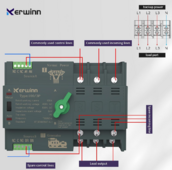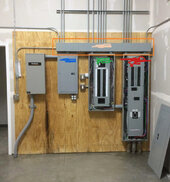OK. An AIO string inverter seems to be cost effective when compared to microinverters and a piece of backup hardware.
The load paths from grid to critical load panel is linear and goes through the AIO.
If the grid fails the AIO starts up and supplies only the critical load panel.
If I build the panels up on a gutter like this,
Image from reddit.
my main power is coming up from basement slab , on right tagged with some red.
AIO is green,
Subpanel is blue on left.
In the gutter I run the single neutral path and the ground path through there and tee off of them where I tagged it with Tan, using a bus bar for ground and a Polaris for neutral.
This ensures no neutral loop condition.
View attachment 215801
In the inside premise wiring, I propose using a different color of wire jacket for the critical loads circuits. Say white for regular and yellow for the Critical Loads (CR)
Where the CR lighting circuit occupies the same duplex switch plate as another circuit, use a common plate but a divided box so there is no possibility of looping there.
I say this because I just want those main navigation lights to work on backup, not every light circuit in the house. This helps with the " load to be served" rules.
If I try to serve them all off CR, the thing gets bloated for no need.
@timselectric does this look like a good plan to pass inspection without a lot of grief?
My big concern is the regulatory certification for the AIO. I don't want to put in a functional piece that does not pass all the requirements of the 2020 NEC.
I am in Washington state and they are at NEC 2020 until sometime in 2025 TBD.
I will do everything possible to get this done in 2024





